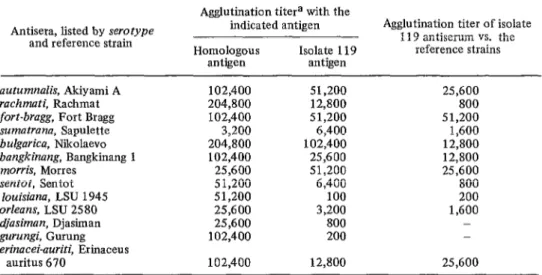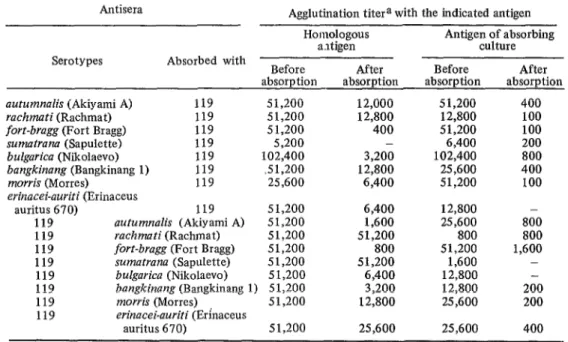LEPTOSPIRA FORT-BRAGG ISOLATED FROM A RAT
IN BARBADOS1
Donald M. Myers, M.T.,2 and C. June Jones, B.Sc.3
A strain of Leptospira isolated from kidney tissue of a rat (Rattus rattus) from Barbados proved to be serotype fort- bragg of the Autumnalis group. This is the first known report of an isolation of this serotype from an animal species. Introduction
Leptospira fort-bragg, a serotype of the Autumnalis group, was isolated for the first time in 1952 from material collected in North Carolina, U.S.A., between 1942 and 1944 during outbreaks of human illness called “Fort Bragg fever” (1). Later efforts in the area to identify an animal reservoir for this serotype were unsuccessful (2). The second known hu- man outbreak of leptospirosis caused by sero- type fort-bragg occurred in Oregon; this out- break was the subject of a recent report by Fraser, et al. (3). Again, wildlife trapped in the outbreak area failed to point to a host-reservoir for these infections. Until now, serotype fort- bragg has never been isolated from any animal species, its established mode of spread to man is unknown, and no isolation of the serotype has ever been reported outside the United States.
Turning to other events, there was a high incidence of human leptospirosis in Barbados during 1970 and 1971. Eighty-eight clinical cases were reported among hospital admissions during this period, with 25 cases (28.4 per cent) terminating in death (4). As a result of these infections, serologic surveys were conducted by the Veterinary Diagnostic Laboratory in Barba- dos, in collaboration with the Pan American
1 Also appearing in Spanish in the Bolefin de la Oficina Sanitaria Panamericana. Vol. LXXX, 1976.
2Leptospirosis Unit, Pan American Zoonoses Cen- ter, Pan American Health Organization, P.O. Box 23, Ramos Mejia, Buenos Aires, Argentina.
3Ministry of Agriculture, Science, and Technology, P.O. Box 505, St. Michael, Barbados, W.I.
Zoonoses Center in Buenos Aires, Argentina, to determine the prevalence of leptospirosis among the island’s domestic and wild animal populations. These surveys revealed that a high percentage of animal sera, mainly cattle sera, showed leptospiral agglutinins to one or more of a diverse group of pathogenic serotypes used as antigens in the microscopic agglutination test (MA). Antigen-antibody reactions occurred most frequently with the Autumnalis group serotypes morris (strain Morres), autumnalis (strain Akiyami A), and Orleans (strain LSU 2580) which were employed as antigens. Of 667 bovine sera collected during 1971 and 1972, over fifty per cent reacted at a serum dilution of 1: 100 or greater, with MA titers as high as 1: 12,800 against these antigens.
Later, as reported by Jones (4), twelve Leptospira strains were isolated from kidney tissues of 80 rodents trapped in Barbados. These were tentatively classified as follows: six were placed in the Icterohaemorrhagiae group, three in the Ballum group, two in the Canicola group, and one in the Autumnalis group. This communication concerns isolation of this latter Autumnalis strain from a rat (Rattus rattus) and its identification as serotype fort-bragg.
Methods and Results
The rat was trapped live on the Sandford Plantation in St. Philip Parish, Barbados, in February 1973, at a time when a dairy herd was kept on the premises. The rat was killed and a necropsy performed. Urine obtained by bladder
Myers and Jones . LEPTOSPIRA FORT-BRAGG ISOLATED IN BARBADOS 209
puncture and examined by dark-field micros- copy showed that leptospires were present. Kidney tissue was cultured, using the dilution technique described by Galton, et al. (.S), in culture tubes containing 5.0 ml of Fletcher semisolid medium (Difco) enriched with 10 per cent rabbit serum. Also, the pyrimidine ana- logue 5fluorouracil (Hoffmann-LaRoche, Inc.) at a final concentration of 0.2 mg/ml and acti-dione at 1 mg/ml were incorporated into replicate series of inoculated culture tubes to control contamination.
Inoculated cultures were incubated at 30°C and examined weekly for leptospires by dark- field microscopy. Three weeks after inocula- tion, when leptospiral growth was detected, successive transfers were made in fresh media until growth was sufficiently abundant for adaptation to Stuart liquid medium (Difco). Once the leptospiral isolate’s growth in Stuart medium had made it satisfactory for use as antigen, the isolate (from rat No. 119) was tested against a battery of prepared hyperim- mune rabbit antisera to determine its sero- group. On the basis of cross-agglutination re- actions against these antisera, which were repre-
sentative of the 16 pathogenic Leptospira sero- groups, it was established that the rat isolate belonged within the Autumnalis group.
Experimental animal inoculations, using three groups of six 21-day-old hamsters inocu- lated intraperitoneally with 0.5 ml of the culture, repeatedly produced death in all of the animals within 4 to 5 days.
Specific antiserum against the rat isolate was prepared in rabbits, using as inocula heat-killed Fletcher semisolid cultures exposed to 56OC for 10 minutes. This antiserum was then employed in cross-agglutination tests against the 13 recog- nized members of the Autumnalis group. In addition, for definitive identification the anti- serum was tested with the cross-agglutination- absorption procedures of Kmety, et al. (6).
The cross-agglutination reactions obtained between antigens and antisera from rat isolate 119 and individual members of the group are shown in Table 1. When the rat isolate was compared to selected Autumnalis serotypes in reciprocal agglutination-absorption tests, it was found to be serologically homologous to sero- type fort-bragg on the basis of current taxo- nomic criteria (see Table 2). The non-reciprocal
TABLE I-Results of cross-agglutination tests with the Leptospira isolate from rat No. 119,
showing its antigenic relationships to serotypes of the Autumnalii group.
Antisera, listed by serotype
and reference strain
Agglutination titera with the indicated antigen Homologous Isolate 119
Agglutination titer of isolate 119 antiserum VS. the
reference strains
antigen antigen
autumnalis, Akiyami A
rachmati, Rachmat
fort-bragg, Fort Bragg
sumatrana, Sapulette
bzdgarica, Nikolaevo
bangkinang, Bangkinang 1
morris, Morres
sentot, Sentot
louisiana, LSU 1945
Orleans, LSU 2580
djasiman, Djasiman
gurungi, Gurung
erinacei-auriti, Erinaceus auritus 670
102,400 51,200
204,800 12,800
102,400 51,200
3,200 6,400
204,800 102,400
102,400 25,600
25,600 51,200
51,200 6,400
51,200 100
25,600 3,200
25,600 800
102,400 200
25,600 800 51,200 1,600 12,800 12,800 25,600 800 200 1,600 -
102,400 12,800 25,600
210 PAHO BULLETIN . Vol. IX, No. 3, 19 7.5
TABLE 2-Results of cross-agglutination-absorption tests with the Leprospira isolate from rat 119 and selected serotypes of the Autumnalis group.
Antisera
autumnalis (Akivami A)
Agglutination titera with the indicated antigen Homologous
antigen Antige;uT:uaisorbing Absorbed with
Before After Before After
absorption absorption absorption absorption
119 51,200 12,000 51,200 400
rachmati (Rachmat) 119
fort-bragg (Fort Bragg) 119
sumatrana (Sapulette) 119
bdgarica (Nikolaevo) 119
bangkinang (Bangkinang 1) 119
morris (Morres) 119
erinacei-auriti (Erinaceus
auritus 670) 119
119 autumnalis (Akiyami A)
51,200 51,200 5,200 102,400 ,51,200 25,600 51,200 51,200
2;SOO 12,800 100
400 51,200 100
3,200 102,400 6,400 200 800
2,800 25,600 400
6,400 51,200 100
6,400 12,800
1,600 25,600 800
119 rachmati (Rachmat) 51,200 51,200 800 800 119 fort-bragg (Fort Bragg) 51,200 800 51,200 1,600 119 sumatrana (Sapulette) 51,200 51,200 1,600 - 119 bulgarica (Nikolaevo) 51,200 6,400 12,800 - 119 bangkinang (Bangkinang 1) 51,200 3,200 12,800 200 119 morris (Morres) 51,200 12,800 25,600 200 119 erinacei-auriti (Erinaceus
auritus 670) 51,200 25,600 25,600 400
aReciprocal of the highest dilution showing 50 per cent or inore agglutination. - Indicates less than 50 per cent agglutination at a 1: 100 serum dilution,
cross-absorption findings with the other the absorbing culture and serotype fort-bragg, Autumnalis strains does not contradict this as well as cross-reactivity to serotypes auturn- classification. Similar inter-relationships among nalis, morris, and Orleans, had been removed. leptospiras are known to occur, a fact which These findings suggest, with a high degree of has prompted discontinuation of the so-called probability, that serotype fort-bragg is involved “incomplete biotype” designations. in cattle infection in Barbados.
A serologic attempt was made to relate this
fort-bragg isolation from a rat to the high incidence of Autumnalis agglutinins in the sera of cattle in Barbados. In these tests, two random bovine sera which showed MA titers of 1:3,200 and 1:6,400 to the reference fort-bragg strain antigen were absorbed with the rat isolate No. 119 culture. Repeat MA tests made with the absorbed sera showed that all agglutinins to
Futher investigations are needed to define the role of serotype fort-bragg in the epidemi- ology of leptospirosis in Barbados. Because the Leptospira serotype causing human death in Barbados is still unidentified and could be serotype fort-bragg, there is good reason to make intensive efforts to achieve cultural isola- tion of leptospires from hospitalized cases.
SUMMARY
Myers and Jones . LEPTOSPIRA FORT-BRAGG ISOLATED IN BARBADOS 211
REFERENCES (I) Gochenour, W. S., J. E. Smadel, E. B. Jackson, er
aZ. Leptospiral etiology of Fort Bragg fever.
Public Health Rep 61: 811-814,1952.
(2) Galton, M. M., N. Hirschberg, R. W. Menges, et al. An investigation of possible wild animal hosts of leptospires in the area of the ‘%ort Bragg fever” outbreaks. Am J Public Health 49:
1343-1348, J.959.
(3) Fraser, D. W:, J. W. Glosser, D. P. Francis, et al.
Leptospirosis caused by serotype forf-bragg: A suburban outbreak. Ann Intern Med 79:
786-789, 1973.
(4) Jones, C. J. Preliminary report on the isolation of
twelve Leptospira serotypes in Barbados. West Indian Med J 65: 65-68, 1974.
(5) Galton, M. M., R. W. Menges, E. B. Shotts, et al.
Leptospirosis: Epidemiology, Clinical Manifes- tations in Man and Animals, and Methods in Laboratory Diagnosis. U.S. Public Health Ser- vice, Washington,D.C., 1962 (U.S.P.H.S. Publi- cation No. 95 1.)
(6) Kmety, E., M. M. Galton, C. R. Sulzer. Further standardization of the agglutinin-absorption test in the serology of leptospires. Bull WHO
42: 733-738, 1970.
CARIBBEAN FOOD AND NUTRITION INSTITUTE WINS MAURICE PATE MEMORIAL AWARD

